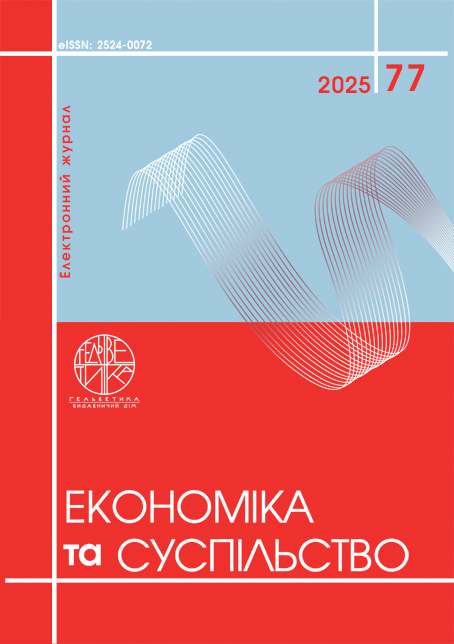THEORETICAL PRINCIPLES OF FORMING MECHANISMS FOR DEVELOPMENT OF BUSINESS STRUCTURES IN A CHANGING BUSINESS ENVIRONMENT
Abstract
The article provides a comprehensive study of the theoretical foundations for the formation of mechanisms for the development of business structures in a changing entrepreneurial environment, which is particularly relevant for Ukraine during the period of military and post-war transformations. It is emphasised that modern business structures operate in a situation of constant uncertainty caused by global economic crises, technological breakthroughs, changing consumer patterns, geopolitical risks and socio-demographic factors. It has been established that traditional approaches to enterprise development management no longer provide sufficient flexibility, so the concepts of dynamic capabilities, digital transformation and anti-fragility are becoming key. The role of dynamic digital capabilities in ensuring the ability of businesses to respond quickly to changes, integrate new technologies, and transform business models in line with market needs is revealed. It is shown that anti-fragility, as the ability to benefit from uncertainty and crisis phenomena, is becoming a strategic advantage for modern companies. Particular attention is paid to the role of innovative management tools as catalysts for the formation of sustainable and competitive business structures. The article proposes a conceptual model of business development that integrates four basic elements: adaptability, innovation, digitalisation, and anti-fragility. Its implementation contributes to improving management efficiency, ensuring competitive advantages, and strengthening the economic sustainability of enterprises in the long term. The presented algorithm for the development of business structures in a changing entrepreneurial environment details the conceptual model and reflects the processes of control and correction. The practical significance of the study lies in the possibility of using the model as a strategic planning tool for Ukrainian and foreign companies operating in a turbulent environment.
References
Гнатюк, О., Катана, В., & Сахнацький, М. (2025). Стратегічне управління підприємницькими структурами. Таврійський науковий вісник. Серія: Економіка, 22, 185-192. doi: https://doi.org/10.32782/2708-0366/2024.22.20
Гринько, Т., & Дулєпов, С. (2025). Підприємницьке середовище: сутність, особливості та сучасний стан. Актуальні проблеми економіки, 1(283), 175-188. doi: https://doi.org/10.32752/1993-6788-2025-1-283-175-188
Іванов, Р., Гринько, Т., & Іванов, К. (2025) Модельна оцінка ефективності використання штучного інтелекту в економіці. Актуальні проблеми економіки, 5(287), 362-371. doi:: 10.32752/1993-6788-2025-1-287-362-371
Благодир, О., & Лемішовська, О. (2024). Особливості реалізації бізнес процесів суб’єктів господарювання в умовах цифрової трансформації та їх вплив на організацію обліку. Економіка та суспільство, (61). doi: https://doi.org/10.32782/2524-0072/2024-61-132.
Бут-Гусаїм, О. Г. (2024). Інноваційний розвиток бізнес-структур в умовах турбулентності. Business Inform, №5, с. 78–86. DOI: doi: https://doi.org/10.32983/2222-4459-2024-2-72-81
Мних, О. Б., Дуляба, Н. І., Мацевко, Б. В., Мазник, Ю. І., & Старецький, А. О. (2025). Інтегровані підходи до розвитку бізнес-структур в умовах кризи: соціальна відповідальність, цифрова трансформація та маркетингові стратегії. Академічні візії, (43) doi: https://doi.org/10.5281/zenodo.15653021
Полінкевич, O. (2020). Адаптивний механізм управління змінами у бізнес-структурах в умовах covid-19. Європейський науковий журнал Економічних та Фінансових інновацій, 2(6), 173-182. doi: https://doi.org/10.32750/2020-0216
Порохня, В., & Іванов, Р. В. (2018). Узагальнена модель формування економічної поведінки домогосподарств в умовах економічної нестабільності. Економічний простір, (133), 80-90. doi: https://doi.org/10.30838/ P.ES.2224.050718.80.72
Koshelenko, K. (2024). Management in Times of War: Leadership Examples from Ukraine's Government and Private Sector. Ultimate Beneficiary Publishing.
Ciampi, F., Faraoni, M., Ballerini, J., & Meli, F. (2022). The co-evolutionary relationship between digitalization and organizational agility: Ongoing debates, theoretical developments and future research perspectives. Technological Forecasting and Social Change, 176, 121383. doi: https://doi.org/10.1016/j.techfore.2021.121383
Taleb, N.N., & West, J. (2023). Working with convex responses: Antifragility from finance to oncology. Entropy , 25 (2), 343. doi: https://doi.org/10.3390/e25020343
Akib, H., Furkan, N., Sumarno, S., Budidarma, A., Salam, R., & Hadi, S. (2022). Business resilience in the digital transformation era. PINISI Discretion Review, 6(1), 95. doi: https://doi.org/10.26858/pdr.v6i1.37708
Balta, M., Papadopoulos, T., & Spanaki, K. (2024). Business model pivoting and digital technologies in turbulent environments. International Journal of Entrepreneurial Behavior & Research, 30(2-3): 773–799. doi: https://doi.org/10.1108/IJEBR-02-2023-0210
Bocken, N. (2023). Business Models for Sustainability. Oxford Research Encyclopedia of Environmental Science, Forthcoming. URL: http://dx.doi.org/10.2139/ssrn.4731205
Karnowski, J., & Szufel, P. (2025). Ukrainian-style oligarchic economies: how concentrated power undermines value added in production chains. arXiv preprint arXiv:2508.02949.
OECD.Future-Proofing SME and Entrepreneurship Policies. URL: https://www.oecd.org/content/dam/oecd/en/topics/policy-issues/smes-and-entrepreneurship/2023-ministerial-documents/Ministerial-key-issues-paper 2023.pdf
Porterm M. E. (2008). The Five Competitive Forces That Shape Strategy. Harvard Business Review, 86(1), 78 – 93.
Старов, О. (2025). Еволюція методологічних підходів до стратегічного управління від класичних концепцій до адаптивних моделей. Економіка та суспільство, (71). doi: https://doi.org/10.32782/2524-0072/2025-71-98
Mele, G., Capaldo, G., Secundo, G., & Corvello, V. (2024). Revisiting the idea of knowledge-based dynamic capabilities for digital transformation. Journal of Knowledge Management, 28(2), 532-563. doi: https://doi.org/10.1108/JKM-02-2023-0121
Held, P., Heubeck, T. & Meckl, R. (2025) Boosting SMEs’ digital transformation: the role of dynamic capabilities in cultivating digital leadership and digital culture. Rev Manag Sci . doi: https://doi.org/10.1007/s11846-025-00919-5
Leso, B.H., Cortimiglia, M.N., Ghezzi, A., & Minatogawa, V. (2024) Exploring digital transformation capability via a blended perspective of dynamic capabilities and digital maturity: a pattern matching approach. Rev Manag Sci, 18(4), 1149–1187. https://doi.org/10.1007/s11846-023-00692-3
Ronalter, L. M., & Bernardo, M. (2023). Integrated management systems and sustainability–a review on their relationships. Total Quality Management & Business Excellence, 34(11-12), 1438-1468. doi: https://doi.org/10.1080/14783363.2023.2178407
Gulati, R. (1998). Alliances and networks. Strategic Management Journal, 19(4), 293–317. doi: https://doi.org/10.1002/(SICI)1097-0266(199804)19:4<293::AID-SMJ982>3.0.CO;2-M
Yoshikuni, A. C., Dwivedi, R., Kamal, M. M., Zhou, D., Dwivedi, P., & Apolinario, S. (2024). A dynamic information technology capability model for fostering innovation in digital transformation. Journal of Innovation & Knowledge, 9(4), 100589. doi: https://doi.org/10.1016/j.jik.2024.100589
van de Wetering, R., Mikalef, P., & Pateli, A. (2018). Strategic Alignment Between IT Flexibility and Dynamic Capabilities: An Empirical Investigation. International Journal of IT/Business Alignment and Governance (IJITBAG), 9(1), 1-20. doi: https://doi.org/10.4018/IJITBAG.2018010101
Sony Interactive’s Paul Walsh on Digital Evolution: Make the Technology Invisible. URL: https://deloitte.wsj.com/cio/sony-interactives-paul-walsh-on-digital-evolution-make-the-technology-invisible-c3b81fbd
UNDP. Support to the Economic Recovery of Ukraine. URL: https://www.undp.org/sites/g/files/zskgke326/files/2024-02/undp-supporteconomicrecoveryukraine2024en_v04.pdf
Ключові виклики для бізнесу у 2025 році. URL: https://news.finance.ua/ua/klyuchovi-vyklyky-dlya-biznesu-u-2025-roci
Іванов , К. (2024). Модельна оцінка впливу показників соціально-економічного розвитку україни на міграційні процеси. Економіка та суспільство, (64). doi: https://doi.org/10.32782/2524-0072/2024-64-49
Less Bureaucracy, More Business: Ukraine’s Digital Transformation. URL: https://digitalstate.gov.ua/news/govtech/less-bureaucracy-more-business-ukraines-digital-transformation
Hnatiuk, O., Katana, V., & Sakhnatskyi, M. (2025). Stratehichne upravlinnia pidpryiemnytskymy strukturamy [Strategic management of business structures]. Tavriiskyi naukovyi visnyk. Seriia: Ekonomika – Tavria Scientific Bulletin. Series: Economics, 22, 185-192. doi: https://doi.org/10.32782/2708-0366/2024.22.20. [in Ukrainian]
Grynko, T., & Duliepov, S. (2025). Pidpryiemnytske seredovyshche: sutnist, osoblyvosti ta suchasnyi stan [Business environment: essence, features and current state]. Aktualni problemy ekonomiky – Actual problems of the economy, 1(283), 175-188. doi: https://doi.org/10.32752/1993-6788-2025-1-283-175-188. [in Ukrainian]
Ivanov, R., Grynko, T., & Ivanov, K. (2025) Modelna otsinka efektyvnosti vykorystannia shtuchnoho intelektu v ekonomitsi [Model assessment of the effectiveness of using artificial intelligence in the economy]. Aktualni problemy ekonomiky – Actual problems of the economy, 5(287), 362-371. doi:: https://doi.org/10.32752/1993-6788-2025-1-287-362-371. [in Ukrainian]
Blahodyr, O., & Lemishovska, O. (2024). Osoblyvosti realizatsii biznes protsesiv subiektiv hospodariuvannia v umovakh tsyfrovoi transformatsii ta yikh vplyv na orhanizatsiiu obliku [Peculiarities of implementing business processes of business entities in the context of digital transformation and their impact on the organization of accounting]. Ekonomika ta suspilstvo – Economy and Society, (61). doi: https://doi.org/10.32782/2524-0072/2024-61-132. [in Ukrainian]
But-Husaim, O. H. (2024). Innovatsiinyi rozvytok biznes-struktur v umovakh turbulentnosti [Innovative development of business structures in turbulent conditions], Business Inform, №5, с. 78–86. DOI: doi: https://doi.org/10.32983/2222-4459-2024-2-72-81. [in Ukrainian]
Mnykh, O. B., Duliaba, N. I., Matsevko, B. V., Maznyk, Yu. I., & Staretskyi, A. O. (2025). Intehrovani pidkhody do rozvytku biznes-struktur v umovakh kryzy: sotsialna vidpovidalnist, tsyfrova transformatsiia ta marketynhovi stratehii [Integrated approaches to the development of business structures in times of crisis: social responsibility, digital transformation and marketing strategies]. Akademichni vizii – Academic visions, (43) doi: https://doi.org/10.5281/zenodo.15653021. [in Ukrainian]
Polinkevych, O. (2020). Adaptyvnyi mekhanizm upravlinnia zminamy u biznes-strukturakh v umovakh covid-19 [Adaptive mechanism for managing changes in business structures in the context of covid-19]. Yevropeiskyi naukovyi zhurnal Ekonomichnykh ta Finansovykh innovatsii – European Scientific Journal of Economic and Financial Innovations, 2(6), 173-182. doi: https://doi.org/10.32750/2020-0216. [in Ukrainian]
Porokhnia, V., & Ivanov, R. V. (2018). Uzahalnena model formuvannia ekonomichnoi povedinky domohospodarstv v umovakh ekonomichnoi nestabilnosti [A generalized model of the formation of economic behavior of households in conditions of economic instability]. Ekonomichnyi prostir – Economic space, (133), 80-90. doi: https://doi.org/10.30838/ P.ES.2224.050718.80.72. [in Ukrainian]
Koshelenko, K. (2024). Management in Times of War: Leadership Examples from Ukraine's Government and Private Sector. Ultimate Beneficiary Publishing.
Ciampi, F., Faraoni, M., Ballerini, J., & Meli, F. (2022). The co-evolutionary relationship between digitalization and organizational agility: Ongoing debates, theoretical developments and future research perspectives. Technological Forecasting and Social Change, 176, 121383. doi: https://doi.org/10.1016/ j.techfore.2021.121383
Taleb, N.N., & West, J. (2023). Working with convex responses: Antifragility from finance to oncology. Entropy , 25 (2), 343. doi: https://doi.org/10.3390/e25020343
Akib, H., Furkan, N., Sumarno, S., Budidarma, A., Salam, R., & Hadi, S. (2022). Business resilience in the digital transformation era. PINISI Discretion Review, 6(1), 95. doi: https://doi.org/10.26858/pdr.v6i1.37708
Balta, M., Papadopoulos, T., & Spanaki, K. (2024). Business model pivoting and digital technologies in turbulent environments. International Journal of Entrepreneurial Behavior & Research, 30(2-3): 773–799. doi: https://doi.org/10.1108/IJEBR-02-2023-0210
Bocken, N. (2023). Business Models for Sustainability. Oxford Research Encyclopedia of Environmental Science, Forthcoming. URL: https://ssrn.com/abstract=4731205 or http://dx.doi.org/10.2139/ssrn.4731205
Karnowski, J., & Szufel, P. (2025). Ukrainian-style oligarchic economies: how concentrated power undermines value added in production chains. arXiv preprint arXiv:2508.02949.
OECD.Future-Proofing SME and Entrepreneurship Policies. Retrieved from https://www.oecd.org/content/dam/oecd/en/topics/policy-issues/smes-and-entrepreneurship/2023-ministerial-documents/Ministerial-key-issues-paper 2023.pdf
Porterm M. E. (2008). The Five Competitive Forces That Shape Strategy. Harvard Business Review, 86(1), 78 – 93.
Starov, O. (2025). Evoliutsiia metodolohichnykh pidkhodiv do stratehichnoho upravlinnia vid klasychnykh kontseptsii do adaptyvnykh modelei [Evolution of methodological approaches to strategic management from classical concepts to adaptive models]. Ekonomika ta suspilstvo – Economy and Society, (71). doi: https://doi.org/10.32782/2524-0072/2025-71-98. [in Ukrainian]
Mele, G., Capaldo, G., Secundo, G., & Corvello, V. (2024). Revisiting the idea of knowledge-based dynamic capabilities for digital transformation. Journal of Knowledge Management, 28(2), 532-563. doi: https://doi.org/10.1108/JKM-02-2023-0121
Held, P., Heubeck, T. & Meckl, R. (2025) Boosting SMEs’ digital transformation: the role of dynamic capabilities in cultivating digital leadership and digital culture. Rev Manag Sci . doi: https://doi.org/10.1007/s11846-025-00919-5
Leso, B.H., Cortimiglia, M.N., Ghezzi, A., & Minatogawa, V. (2024) Exploring digital transformation capability via a blended perspective of dynamic capabilities and digital maturity: a pattern matching approach. Rev Manag Sci, 18(4), 1149–1187. https://doi.org/10.1007/s11846-023-00692-3
Ronalter, L. M., & Bernardo, M. (2023). Integrated management systems and sustainability–a review on their relationships. Total Quality Management & Business Excellence, 34(11-12), 1438-1468. doi: https://doi.org/10.1080/14783363.2023.2178407
Gulati, R. (1998). Alliances and networks. Strategic Management Journal, 19(4), 293–317. doi: https://doi.org/10.1002/(SICI)1097-0266(199804)19:4<293::AID-SMJ982>3.0.CO;2-M
Yoshikuni, A. C., Dwivedi, R., Kamal, M. M., Zhou, D., Dwivedi, P., & Apolinario, S. (2024). A dynamic information technology capability model for fostering innovation in digital transformation. Journal of Innovation & Knowledge, 9(4), 100589. doi: https://doi.org/10.1016/j.jik.2024.100589
van de Wetering, R., Mikalef, P., & Pateli, A. (2018). Strategic Alignment Between IT Flexibility and Dynamic Capabilities: An Empirical Investigation. International Journal of IT/Business Alignment and Governance (IJITBAG), 9(1), 1-20. doi: https://doi.org/10.4018/IJITBAG.2018010101
Sony Interactive’s Paul Walsh on Digital Evolution: Make the Technology Invisible. URL: https://deloitte.wsj.com/cio/sony-interactives-paul-walsh-on-digital-evolution-make-the-technology-invisible-c3b81fbd
UNDP. Support to the Economic Recovery of Ukraine. Retrieved from https://www.undp.org/sites/g/files/zskgke326/files/2024-02/undp-supporteconomicrecoveryukraine2024en_v04.pdf
Kliuchovi vyklyky dlia biznesu u 2025 rotsi [Key challenges for business in 2025]. Retrieved from https://news.finance.ua/ua/klyuchovi-vyklyky-dlya-biznesu-u-2025-roci . [in Ukrainian]
Ivanov, K. (2024). Modelna otsinka vplyvu pokaznykiv sotsialno-ekonomichnoho rozvytku ukrainy na mihratsiini protsesy [Model assessment of the impact of indicators of socio-economic development of Ukraine on migration processes]. Ekonomika ta suspilstvo – Economy and Society, (64). doi: https://doi.org/10.32782/2524-0072/2024-64-49. [in Ukrainian]
Less Bureaucracy, More Business: Ukraine’s Digital Transformation. Retrieved from https://digitalstate.gov.ua/news/govtech/less-bureaucracy-more-business-ukraines-digital-transformation
Copyright (c) 2025 Тетяна Гринько, Сергій Дулєпов

This work is licensed under a Creative Commons Attribution 4.0 International License.


